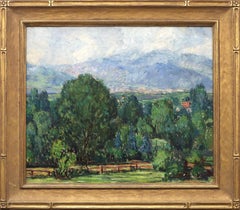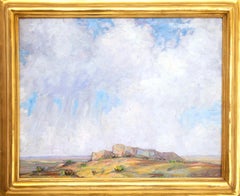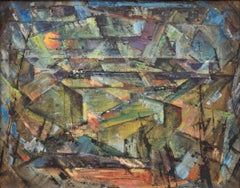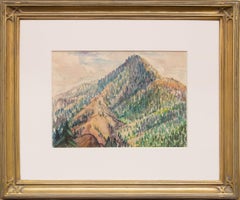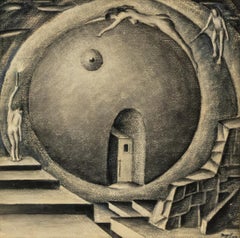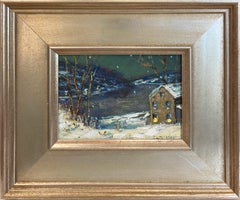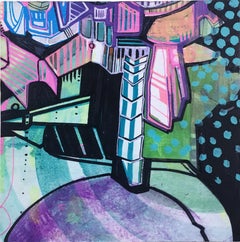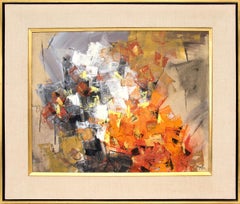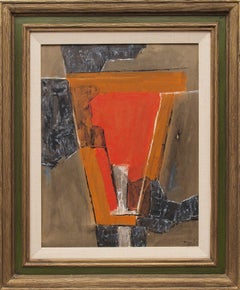Charles Ragland Bunnell Art
American, 1897-1968
Charles Bunnell developed a love for art at a very young age. As a child in Kansas City, Missouri, he spent much of his time drawing. When he was unable to find paper he drew on walls and in the margins of textbooks for which he was often fined. Around 1915, Bunnell moved with his family to Colorado Springs, Colorado. He served in World War I and later used his GI Training to study at the Broadmoor Art Academy (later renamed the Colorado Springs Fine Arts Center) during 1922 and 1923.
In 1922, he married fellow student, Laura Palmer. He studied with Ernest Lawson in 1927-1928 and, in the winter of 1928-1929, he served as Lawson’s assistant. In the late 1920’s, the Bunnell’s settled just west of Colorado Springs and 1928, they welcomed the first of their three children. Their one-acre homesite, which they referred to as “Old Home Place”, was situated between two sets of railroad tracks at the foot of Pike’s Peak. Charlie converted an old railroad boxcar into his studio, where he later gave lessons.
Beginning in 1931, Bunnell spent a year and a half studying under Boardman Robinson. The two men clashed constantly due to a generation gap and markedly different philosophies. Robinson encouraged his students not to stray from realism and though Bunnell mastered Robinson’s preferred style of American Scene painting, he regularly irritated his professor with his abstract sketches.
Bunnell taught at the Kansas City Art Institute during the summers of 1929, 1930, 1940, and 1941. Between 1934 and 1941, he painted and taught under federal projects which included assisting Frank Mechau on murals for the Colorado Springs Post Office. However, he did not take to mural making and, after criticism from Boardman Robinson about his use of “heavy daubs which have no place in mural work,” he abandoned mural-making altogether.
By the late 1930’s, Bunnell’s work departed from the American Scene/Modernist style he was trained in towards abstraction. This is marked by his “Black and Blue” series, consisting of 83 abstracted ink and watercolors. Affected by the Second World War and the loss of his 10-year old son, Bunnell’s work of the early 1940’s took on a Transcendental and Surrealist tone. The works from this period are moody and readily reflect the political and personal turmoil experienced by the artist.
In the late 1940’s, Bunnell began experimenting with Abstract Expressionism. He alone is credited with introducing Colorado Springs to the new style as it was excluded from the Fine Art Center’s curriculum by Boardman Robinson. Bunnell excelled in Abstract Expressionism and continued to evolve in the style through the 1950’s continuing to his death in 1968. He was recently recognized as a premier American Abstract Expressionist by his inclusion in the book American Abstract Expressionism of the 1950’s: An Illustrated Survey. © David Cook Galleries, LLC
to
8
18
18
16
5
5
4
2
2
1
Dealer: David Cook Galleries
Original 1940s Retrofuturism Gouache Painting 'Birth of Mind' in Black & White
By Charles Ragland Bunnell
Located in Denver, CO
This vintage 1940s gouache painting, titled Birth of Mind, is a striking example of retrofuturism by Charles Ragland Bunnell, a prominent artist from the Broadmoor Academy...
Category
1940s Futurist Charles Ragland Bunnell Art
Materials
Gouache
View from the Park Colorado Summer Mountain Landscape 20th Century Oil Painting
By Charles Ragland Bunnell
Located in Denver, CO
"View from the Park" is a stunning oil on canvas painting by Charles Ragland Bunnell (1897-1968), showcasing the serene beauty of a Colorado landscape. The artwork captures a peacefu...
Category
Mid-20th Century American Modern Charles Ragland Bunnell Art
Materials
Oil
1920s Colorado Western Landscape Oil Painting, Blue Sky, Buttes, & Mountain Art
By Charles Ragland Bunnell
Located in Denver, CO
This original 1926 signed oil painting by 20th cenutry artist Charles Ragland Bunnell (1897-1968) beautifully captures the expansive Colorado prairie landscape. Created while Bunnell...
Category
1920s American Impressionist Charles Ragland Bunnell Art
Materials
Oil, Board
Moonrise Over Colorado Springs: 1950s Abstract Oil Painting Green, Blue & Ochre
By Charles Ragland Bunnell
Located in Denver, CO
"Moonrise Over Colorado Springs" is a striking 1950s abstract expressionist oil painting by renowned artist Charles Ragland Bunnell. Created in 1952, this captivating piece features ...
Category
1950s Abstract Charles Ragland Bunnell Art
Materials
Oil
Cameron's Cone, Colorado Springs – Framed Sunset Watercolor Landscape Painting
By Charles Ragland Bunnell
Located in Denver, CO
This original 1930s watercolor painting by Charles Ragland Bunnell beautifully captures the majestic landscape of Cameron’s Cone near Colorado Springs...
Category
1930s Charles Ragland Bunnell Art
Materials
Watercolor
Man In His Search for God, 1939 WPA Era Original Grey Scale Gouache Painting
By Charles Ragland Bunnell
Located in Denver, CO
This striking vintage 1939 original painting, titled Man In His Search for God, is a powerful piece from Charles Bunnell’s renowned Black and Blue Series. The artwork is painted in i...
Category
1930s Futurist Charles Ragland Bunnell Art
Materials
Gouache
1920s Mountain Landscape Oil Painting of Manitou, Colorado with Pikes Peak View
By Charles Ragland Bunnell
Located in Denver, CO
"Manitou, Colorado with Pikes Peak View" is an original oil on canvas painting by renowned Colorado modernist Charles Ragland Bunnell (1897–1968), created circa 1928–1929. This vibra...
Category
1920s Abstract Impressionist Charles Ragland Bunnell Art
Materials
Oil
"Birth" 1940s Surrealist Abstract Watercolor Painting, Gray Scale Female Figure
By Charles Ragland Bunnell
Located in Denver, CO
"Birth" is a striking semi-abstract watercolor painting created by the talented Colorado artist, Charles Ragland Bunnell, in 1943. The artwork, crafted during Bunnell's Black and Blu...
Category
1940s Surrealist Charles Ragland Bunnell Art
Materials
Watercolor
1940s American Modernist Abstract Industrial Watercolor Ink Charcoal Painting
By Charles Ragland Bunnell
Located in Denver, CO
This original vintage painting by Charles Ragland Bunnell (1897-1968), titled Quitting Time from Bunnell's Black and Blue Series from 1941, exemplifies his unique Abstract Structure ...
Category
1940s American Modern Charles Ragland Bunnell Art
Materials
Charcoal, Ink, Watercolor
1930s WPA Era Graphite Drawing, American Modern City Scene of Houses on Hill, CO
By Charles Ragland Bunnell
Located in Denver, CO
Graphite on paper drawing by Charles Ragland Bunnell (1897–1968), circa 1935, featuring a modernist cityscape of houses on a hill in Colorado. This artwork, created during the 1930s ...
Category
1930s American Modern Charles Ragland Bunnell Art
Materials
Graphite
1950s New York City Abstract Skyline - Moody Night Cityscape Oil Painting
By Charles Ragland Bunnell
Located in Denver, CO
This stunning 1951 oil painting on board by renowned American artist Charles Ragland Bunnell captures an abstracted New York City skyline in a rich nocturnal color palette of black, ...
Category
1950s Abstract Expressionist Charles Ragland Bunnell Art
Materials
Oil
1950s Original Signed Abstract Expressionist Watercolor in Soft Pastel Colors
By Charles Ragland Bunnell
Located in Denver, CO
This soft toned abstract expressionist watercolor painting, created by Charles Ragland Bunnell (1897-1968), is an exceptional example of his evolution as an artist. Featuring bold sw...
Category
1950s Abstract Expressionist Charles Ragland Bunnell Art
Materials
Watercolor
WPA 1940s Framed Figurative Village Landscape with Figures, Houses & Mountains
By Charles Ragland Bunnell
Located in Denver, CO
This evocative watercolor painting, titled The Way War First Comes (1940), was created by noted American artist Charles Ragland Bunnell (1897-1968) during the Depression era. The pie...
Category
1940s American Modern Charles Ragland Bunnell Art
Materials
Watercolor
Golden Cycle Mill Colorado WPA Mining Watercolor, 1940s Grayscale Artwork
By Charles Ragland Bunnell
Located in Denver, CO
Original 1940s grayscale watercolor painting by American artist Charles Ragland Bunnell, capturing a semi-abstracted view of the Golden Cycle Mill in Colorado Springs, Colorado. Painted in subtle shades of black and gray, this unique WPA-era landscape combines industrial subject matter with expressive, modernist style. A striking piece of American regionalist art from the mid-20th century.
The work is presented in a custom black frame.
Framed dimensions: 18" H x 19 ½" W x 1 ⅜" D
Sight size: 8 ⅛" H x 9 ⅝" W
The Golden Cycle Mining and Reduction Company, depicted in this piece, was a major part of Colorado's mining boom in the early 20th century. Located in Colorado City (now part of Old Colorado City), the mill played a significant role in the region’s gold production and industrial development.
About the Artist: Charles Ragland Bunnell (1897–1968)
Charles Bunnell was a pivotal figure in Colorado’s 20th-century art scene. He worked across multiple styles—from representational landscapes to fully abstract compositions—and was one of the few artists in Colorado to successfully embrace the evolving trends of Modernism, Surrealism, and Abstraction after WWII.
Bunnell studied under notable artists at the Broadmoor Art Academy, including Ernest Lawson and Birger Sandzén. His early works, including regional landscapes and mining scenes like this one, showcase a mix of American Scene painting and semi-abstract structure. He later became known for his bold experimentation with color, form, and geometry, producing both expressive oils and ink-watercolor series such as Black and Blue.
He participated in multiple New Deal art...
Category
1940s American Modern Charles Ragland Bunnell Art
Materials
Watercolor
Georgetown, Colorado, 1938 WPA Era Ink Drawing of Rocky Mountain Landscape
By Charles Ragland Bunnell
Located in Denver, CO
This vintage 1938 ink drawing by Charles Bunnell (1897–1968) captures a stunning scene of a church nestled in the majestic Rocky Mountains of Georgetown, Colorado. Executed in bold black ink on creamy white paper, the piece is signed and dated by the artist in the lower right and titled in the lower left. The image size is 7 ¾ x 5 ¾ inches, and it is framed with archival materials, with outer dimensions measuring 16 ¼ x 14 ½ x 1 ¼ inches.
Condition:
The drawing is in good vintage condition, with no notable flaws. For a detailed condition report, please contact us directly.
Provenance:
This artwork comes from the estate of Charles Ragland Bunnell, ensuring its authenticity.
About Charles Bunnell:
Charles Bunnell was a prominent American artist whose career spanned multiple styles and influences. Born in Kansas City, Missouri, he moved to Colorado Springs around 1915, where he developed a love for art. After serving in World War I, Bunnell studied at the Broadmoor Art Academy (later renamed the Colorado Springs Fine Arts Center), where he met his wife, Laura Palmer...
Category
1930s American Modern Charles Ragland Bunnell Art
Materials
Ink
1941 Autumn Landscape of Pikes Peak by Charles Bunnell, American Impressionist
By Charles Ragland Bunnell
Located in Denver, CO
941 Egg Tempera Landscape of Pikes Peak by Charles Bunnell – Autumn in Colorado
This original 1941 egg tempera painting by celebrated Colorado artist Charles Bunnell (1897–1968) bea...
Category
1930s American Impressionist Charles Ragland Bunnell Art
Materials
Tempera
"Sacred Family" 1950s Abstract Figurative Impasto Oil Painting, Red, Blue, White
By Charles Ragland Bunnell
Located in Denver, CO
"Untitled (Sacred Family)" is a powerful abstract oil painting on board by renowned American artist Charles Ragland Bunnell (1897-1968), created circa 1950. Signed by the artist in the lower right corner, this striking piece portrays an abstract interpretation of several figures grouped together, capturing the essence of human connection. The dynamic composition is enhanced by vivid, contrasting colors of black, red, blue, green, orange, yellow, and white, creating a sense of depth and movement within the piece.
This exceptional painting is presented in a vintage frame with outer dimensions of 34 ½ x 29 x 1 ¼ inches, and the image size measures 23 ½ x 18 ¾ inches. It remains in good condition, showcasing Bunnell’s mastery of color, texture, and abstraction. Expedited and international shipping options are available—please contact us for a quote.
About the Artist: Charles Ragland Bunnell, born in 1897 in Kansas City, Missouri, developed a deep passion for art from a young age. His early artistic explorations included drawing on walls and textbooks, eventually leading him to study at the Broadmoor Art Academy (now Colorado Springs Fine Arts Center) under the GI Bill in the early 1920s. After marrying fellow art student Laura Palmer...
Category
1950s Abstract Charles Ragland Bunnell Art
Materials
Oil
Vintage 1960s Mid-Century Modern Abstract Painting – Blue, Gray & Black Art
By Charles Ragland Bunnell
Located in Denver, CO
This original 1963 abstract painting is a stunning piece by Charles Ragland Bunnell (1897–1968), a prominent Colorado Springs artist known for his contributions to mid-century modern...
Category
1960s Abstract Charles Ragland Bunnell Art
Materials
Oil
Related Items
"River Road New Hope" Bucks County PA Midnight with Stars Snow Landscape Scene
Located in New York, NY
A wonderful Impressionist winter pastoral scene of a colorful quaint home by the river. Willet has portrayed this piece in a most intimate, yet energetic way, and has packed much fee...
Category
20th Century American Impressionist Charles Ragland Bunnell Art
Materials
Oil, Board
H 10.5 in W 12.5 in D 1.25 in
My 80's Heart "Token 5" 2019, gouache, acrylic, graphite, panel, purple, green
By Catherine Hart
Located in Jersey City, NJ
My 80's Hart "Token 5" 2019, gouache, acrylic, graphite, panel, purple, green, blue
Category
2010s Contemporary Charles Ragland Bunnell Art
Materials
Acrylic, Gouache, Panel, Wood Panel, Graphite
"Almost Home" Solebury Bucks County PA Twilight Snow Scene Oil Painting Framed
Located in New York, NY
Impressionist winter pastoral scene of a quaint snow covered home by Solebury, Bucks County PA. Willett has portrayed this charming scene in a most intimate, yet energetic way, and h...
Category
20th Century American Impressionist Charles Ragland Bunnell Art
Materials
Oil, Board
"The Green Parasol, " Henry Hannig, American Impressionist, Woman in Beach Scene
By Henry Hannig
Located in New York, NY
Henry Charles Hannig (1883 - 1948)
The Green Parasol
Oil on canvas mounted on board
6 x 7 3/4 inches
Provenance:
R.H. Love Galleries, Chicago, Illinois
Private Collection, Lake Orion, Michigan
Hannig, born in Hirschberg, Germany on 27 February 1883, came to America with his parents at the age of seven. He attended school in the southwest suburbs before the family settled in Chicago. Young Henry enrolled in the Chicago Academy of Fine Arts where Lawton Parker became his mentor. He made ends meet by working in industrial design and illustration.
By 1908 he was a pupil in the School of the Art Institute of Chicago where students followed the traditional European drawing curriculum, beginning with the copying of master engravings and drawing after plaster casts, then concentrating on the nude figure. Students worked toward the goal of winning various academic prizes. One of Hannig's fellow students was Louis Ritman...
Category
1910s American Impressionist Charles Ragland Bunnell Art
Materials
Canvas, Oil, Board
Stewart's Stream, Abstract Oil Painting
By Ronda Waiksnis
Located in San Francisco, CA
Artist Comments
Ronda Waiksnis says of this atmospheric landscape, "I love a direction through nature that leads to the unknown!"
About the Artist
Ronda Waik...
Category
21st Century and Contemporary Abstract Charles Ragland Bunnell Art
Materials
Oil
Signed Lowell Herrero Beach Scene Painting
Located in New York, NY
Lowell Herrero (American, 1921-2015)
Untitled, c. Late 20th-Early 21st Century
Oil on canvas
16 x 20 in.
Framed: 19 3/4 x 23 5/8 in.
Signed lower right:...
Category
Late 20th Century American Modern Charles Ragland Bunnell Art
Materials
Canvas, Oil
H 19.75 in W 23.625 in D 0.5 in
"Santa Catalina Island Harbor" Seascape at Sunset in Oil on Artist's Panel
Located in Soquel, CA
"Santa Catalina Island Harbor" Seascape at Sunset in Oil on Board
Vibrant harbor seascape by Gary J. Schildt (American, 1938-2021). Several boats are anchored in the harbor, with the shore stretching out into the distance along the right side of the composition. The water reflects the yellow and orange sky, creating a shimmering effect.
Signed "G Schildt" in the lower left corner.
Titled and signed on verso "Santa Catalina Island Harbor by Gary Schildt...
Category
Late 20th Century American Impressionist Charles Ragland Bunnell Art
Materials
Canvas, Oil, Illustration Board
H 16.75 in W 19.75 in D 1.5 in
Carmel Mission, 1870 - California School Landscape Oil Painting
Located in Soquel, CA
Carmel Mission, 1870 - Landscape Oil Painting
One of California's Mission settlements lies on the Central Coast in Carmel, depicted in this landscape oil painting. The Spanish architecture...
Category
20th Century American Impressionist Charles Ragland Bunnell Art
Materials
Oil, Board
H 16.5 in W 20.5 in D 1 in
"Spring" Milton Derr, Lyrical Modernist Landscape, Bright Green and Blue Hues
Located in New York, NY
Milton Derr
Spring, 1982
Signed lower right; titled and dated verso
Oil on canvas
26 x 28 inches
Provenance
Acquired by descent from the artist to the present owner
Milton Derr wa...
Category
1980s American Modern Charles Ragland Bunnell Art
Materials
Canvas, Oil
Mod Abstract Expressionist Modernist Edward Avedisian Color Field Art Gouache
By Edward Avedisian
Located in Surfside, FL
Edward Avedisian Gouache Watercolor Abstract Painting on Arches paper. (notebook cover not included)
Unsigned, (bears name verso in pencil.)
Dimensions: 10" X 14"
Late 1970s, early ...
Category
1970s Abstract Expressionist Charles Ragland Bunnell Art
Materials
Watercolor, Gouache
Wells Fargo Express, Gold Country -- Columbia, California
By Cecil F. Chamberlin
Located in Soquel, CA
Charming oil painting of the Wells Fargo Express Office building in the gold country town of Columbia State Historic Park in Columbia, California by Cecil ...
Category
1950s American Impressionist Charles Ragland Bunnell Art
Materials
Canvas, Oil, Illustration Board
H 27 in W 30.75 in D 2 in
"Evening New York Library New York City" Impressionist Snow Scene Oil Painting
Located in New York, NY
Impressionist New York City winter city-scene depicting the New York City Library on 42nd Street with pedestrians going through the snow in a most intimate, yet energetic way. Christ...
Category
20th Century American Impressionist Charles Ragland Bunnell Art
Materials
Oil, Board
Previously Available Items
1960s Abstract Expressionist Oil Painting, Orange, Red, White, Black, Gold
By Charles Ragland Bunnell
Located in Denver, CO
Oil on paper, adhered to board abstract painting in orange, red, white, black, and gold, painted in 1963 by Charles Ragland Bunnell (1897-1968). Signed and dated by the artist in the lower right corner. Presented in a custom vintage frame, outer dimensions measure 22 ½ x 26 ½ x 1 ½ inches. Image size is 16 ¼ x 20 ¼ inches.
Painting is in good condition - please contact us for a detailed condition report.
Provenance: Estate of the artist, Charles Ragland Bunnell
About the Artist:
Born 1897
Died 1968
Charles Bunnell developed a love for art at a very young age. As a child in Kansas City, Missouri, he spent much of his time drawing. When he was unable to find paper he drew on walls and in the margins of textbooks for which he was often fined. Around 1915, Bunnell moved with his family to Colorado Springs, Colorado. He served in World War I and later used his GI Training to study at the Broadmoor Art Academy (later renamed the Colorado Springs Fine Arts Center) during 1922 and 1923.
In 1922, he married fellow student, Laura Palmer. He studied with Ernest Lawson in 1927-1928 and, in the winter of 1928-1929, he served as Lawson’s assistant. In the late 1920’s, the Bunnell’s settled just west of Colorado Springs and 1928, they welcomed the first of their three children. Their one-acre homesite, which they referred to as “Old Home Place”, was situated between two sets of railroad tracks at the foot of Pike’s Peak. Charlie converted an old railroad boxcar into his studio, where he later gave lessons.
Beginning in 1931, Bunnell spent a year and a half studying under Boardman Robinson. The two men clashed constantly due to a generation gap and markedly different philosophies. Robinson encouraged his students not to stray from realism and though Bunnell mastered Robinson’s preferred style of American Scene painting, he regularly irritated his professor with his abstract sketches.
Bunnell taught at the Kansas City Art Institute during the summers of 1929, 1930, 1940, and 1941. Between 1934 and 1941, he painted and taught under federal projects which included assisting Frank Mechau on murals for the Colorado Springs Post Office. However, he did not take to mural making and, after criticism from Boardman Robinson about his use of “heavy daubs which have no place in mural work,” he abandoned mural-making altogether.
By the late 1930’s, Bunnell’s work departed from the American Scene/Modernist style he was trained in towards abstraction. This is marked by his “Black and Blue” series, consisting of 83 abstracted ink and watercolors. Affected by the Second World War and the loss of his 10-year old son, Bunnell’s work of the early 1940’s took on a Transcendental and Surrealist tone. The works from this period are moody and readily reflect the political and personal turmoil experienced by the artist.
In the late 1940’s, Bunnell began experimenting with Abstract Expressionism. He alone is credited with introducing Colorado Springs to the new style as it was excluded from the Fine Art Center’s curriculum by Boardman Robinson. Bunnell excelled in Abstract Expressionism and continued to evolve in the style through the 1950’s continuing to his death in 1968. He was recently recognized as a premier American Abstract Expressionist by his inclusion in the book American Abstract Expressionism of the 1950’s: An Illustrated Survey.
Solo Exhibits: Kansas City Art Institute, Kansas City, Missouri, 1930; Santa Fe Museum, Santa Fe, New Mexico, 1947; University of Illinois, Urbana, Illinois, 1948; University of Kentucky, Lexington, Kentucky, 1949; Taos Gallery, Taos, New Mexico, 1951; Carl Barnett Galleries, Dallas, Texas, 1952; The Bodley Gallery, New York, 1955; Amarillo, Texas, 1955; Haigh Gallery, Denver, Colorado, 1955; Colorado Springs Fine Arts Center, Colorado Springs, Colorado, 1956; Dord Fitz Art Gallery, Amarillo, Texas, December 1956 – February 1957, 1959, 1969 (retrospective).
Group Exhibits: Carnegie Institute, 1927-1928; Colorado State Fair, 1928 (1st prize); Artists Midwestern, Kansas City, Missouri, 1929 (Gold Medal); Art Institute of Chicago, 1947 (the exhibit traveled to ten major museums in the United States); “Artists West of the Mississippi”, Colorado Springs Fine Arts Center, Colorado Springs, Colorado (7 times); Denver Art Museum Western Annual, Denver, Colorado (5 times); Mid-America Annual, Kansas City, Missouri, 1958; First Provincetown Festival, 1958; Southwestern Annual, Santa Fe, New Mexico, Winter 1957-1958; Central City, Colorado; Cañon City...
Category
1960s Abstract Charles Ragland Bunnell Art
Materials
Oil, Archival Paper
H 22.5 in W 26.5 in D 1.5 in
Bull III, 1960s Mid Century Abstract Oil Painting, Orange, Black, Brown
By Charles Ragland Bunnell
Located in Denver, CO
Abstract oil on board signed by Charles Ragland Bunnell (1897-1968) titled 'Bull III' painted in 1963. Presented in the artist’s original frame, outer dimensions measure 27 ½ x 23 ½ ...
Category
1960s Abstract Charles Ragland Bunnell Art
Materials
Oil, Board
Charles Ragland BunnellBull III, 1960s Mid Century Abstract Oil Painting, Orange, Black, Brown, 1963
H 27.5 in W 23.5 in D 1.25 in
1950s Abstract Expressionist Oil Painting, Blue Brown Orange Sage Green
By Charles Ragland Bunnell
Located in Denver, CO
Abstract expressionist oil painting on board from 1955 by Charles Bunnell. Abstract shapes in layers of sage green, light blue, brown, gold, and black. Presented in a custom frame, o...
Category
1950s Abstract Expressionist Charles Ragland Bunnell Art
Materials
Oil, Board
Charles Ragland Bunnell1950s Abstract Expressionist Oil Painting, Blue Brown Orange Sage Green, 1955
H 16.25 in W 20 in D 1 in
1940s Abstract Watercolor Mixed Media Painting by Charles Bunnell
By Charles Ragland Bunnell
Located in Denver, CO
Untitled (Crucifixion, Black & Blue Series) is an original watercolor, charcoal and ink on paper from the artist Charles Ragland Bunnell's (1897-1968) Black & Blue Series from 1941. Abstract composition created in shades of red, gray, white, and black. Presented in a vintage frame, outer dimensions measure 38 ⅝ x 30 ¾ inches. Image size is 29 x 22 inches.
Expedited and International shipping is available - please contact us for a quote.
About the Artist:
Born 1897
Died 1968...
Category
1940s American Modern Charles Ragland Bunnell Art
Materials
Charcoal, Archival Ink, Watercolor, Archival Paper
Old Mine and Mountains, Colorado, 1940s American Modern Landscape Oil Painting
By Charles Ragland Bunnell
Located in Denver, CO
1945 oil painting on canvas by Charles Bunnell of a Colorado mine and mountains. Modernist landscape painting done in colors of red, blue, and cream. Presented in a custom white gold frame measuring 22 ¾ x 26 ¾ inches. Image size is 16 x 20 inches.
Piece is clean and in very good vintage condition - please contact us for a detailed condition report.
Expedited and international shipping is available - please contact us for a quote.
About the Artist:
Charles Bunnell developed a love for art at a very young age. As a child in Kansas City, Missouri, he spent much of his time drawing. When he was unable to find paper he drew on walls and in the margins of textbooks for which he was often fined. Around 1915, Bunnell moved with his family to Colorado Springs, Colorado. He served in World War I and later used his GI Training to study at the Broadmoor Art Academy (later renamed the Colorado Springs Fine Arts Center) during 1922 and 1923.
In 1922, he married fellow student, Laura Palmer...
Category
1940s American Modern Charles Ragland Bunnell Art
Materials
Oil
1960s Abstract Geometric Textured Oil Painting, Orange, Black, Circle & Square
By Charles Ragland Bunnell
Located in Denver, CO
Abstract geometric oil on board painting by Charles Bunnell from 1960 with a black circle above an orange square with various shades of blue, pink, and yellow in the background. Signed and dated by the artist in the lower right corner. Presented in a custom white frame, outer dimensions measure 16 ⅜ x 12 ¼ x 1 inches. Image size is 16 x 12 inches.
Expedited and international shipping is available - please contact us for a quote.
About the artist:
Charles Bunnell developed a love for art at a very young age. As a child in Kansas City, Missouri, he spent much of his time drawing. When he was unable to find paper he drew on walls and in the margins of textbooks for which he was often fined. Around 1915, Bunnell moved with his family to Colorado Springs, Colorado. He served in World War I and later used his GI Training to study at the Broadmoor Art Academy (later renamed the Colorado Springs Fine Arts Center) during 1922 and 1923.
In 1922, he married fellow student, Laura Palmer...
Category
1960s Abstract Charles Ragland Bunnell Art
Materials
Oil
H 16.5 in W 12.25 in D 1 in
1960 Geometric Abstract Oil Painting, Mid Century Modern, Squares Circles
By Charles Ragland Bunnell
Located in Denver, CO
Geometric abstract oil painting on canvas-paper by Charles Bunnell circa 1960. Painting of circles and squares, orange black and white. Presented in a custom black frame, outer dimen...
Category
1960s Abstract Charles Ragland Bunnell Art
Materials
Oil
H 16.25 in W 20.25 in D 1 in
1950s Abstract Expressionist Oil Painting, Framed Mid Century Modern, 16 x 20 in
By Charles Ragland Bunnell
Located in Denver, CO
1950s Abstract Expressionist oil painting Charles Bunnell painted in colors of light green, pale blue, orange, and brown. Presented in a custom f...
Category
1950s Abstract Charles Ragland Bunnell Art
Materials
Oil, Board
H 16.25 in W 20.25 in D 1 in
Untitled (Abstract with Four Nudes), Semi-Abstract Nude, Orange, Green and Blue
By Charles Ragland Bunnell
Located in Denver, CO
Oil on canvaspaper on board painting by Charles Ragland Bunnell (1897-1968) from 1956. Presented in a custom gold tone float frame, outer dimensions measure 22 ¼ x 18 ¼ x 2 inches. ...
Category
1950s Abstract Charles Ragland Bunnell Art
Materials
Oil
H 22.25 in W 18.25 in D 2 in
1950s Abstract Oil Painting, Framed Mid Century Modern Painting, Yellow Black
By Charles Ragland Bunnell
Located in Denver, CO
Abstract oil on canvas paper on board painting by Charles Ragland Bunnell from 1955 painted in colors of black, white, yellow, and gray. Presented in a custom black frame, outer dime...
Category
1950s Abstract Charles Ragland Bunnell Art
Materials
Oil, Board
Black Dog, 1960s Framed Modernist Oil Painting, Pet Portrait, Black White
By Charles Ragland Bunnell
Located in Denver, CO
Black Dog, vintage 1961 original modernist painting of a dog in black, gray and white by Colorado Springs Broadmoor Academy artist, Charles Bunnell (1897-1968. Painted in oil on canvas paper, signed and dated by the artist lower right. Presented in a contemporary custom wood frame with all archival materials, outer dimensions measure 24 ½ x 28 ¼ x 1 ¾ inches. Image size is 20 x 16 inches.
Provenance: Estate of Charles Ragland Bunnell
Expedited and international shipping is available - please contact us for a quote.
About the Artist:
Charles Bunnell developed a love for art as a child in Kansas City, Missouri. Around 1915, Bunnell moved with his family to Colorado Springs, Colorado.
He served in World War I and later used his GI Training to study at the Broadmoor Art Academy (later renamed the Colorado Springs Fine Arts Center) during 1922 and 1923. In 1922, he married fellow student, Laura Palmer...
Category
Mid-20th Century American Modern Charles Ragland Bunnell Art
Materials
Oil
H 24.5 in W 28.25 in D 1.75 in
Pikes Peak, Southern Colorado Mountain Watercolor Painting, 1960s Landscape
By Charles Ragland Bunnell
Located in Denver, CO
Pikes Peak (Colorado) is a watercolor on paper painting by Charles Ragland Bunnell (1897-1968). Painted in colors of blue, green, yellow, and black. Presented in a custom frame with all archival materials and UV protectant glass, outer dimensions measure 13 ⅝ x 14 ⅞ x 1 inches. Image size is 4 ⅜ x 5 ⅝ inches.
Painting is clean and in very good vintage condition - please contact us for a complete condition report.
Expedited and international shipping is available, please contact us for a quote.
About the artist:
Charles Bunnell developed a love for art at a very young age. As a child in Kansas City, Missouri, he spent much of his time drawing. When he was unable to find paper he drew on walls and in the margins of textbooks for which he was often fined. Around 1915, Bunnell moved with his family to Colorado Springs, Colorado. He served in World War I and later used his GI Training to study at the Broadmoor Art Academy (later renamed the Colorado Springs Fine Arts Center) during 1922 and 1923.
In 1922, he married fellow student, Laura Palmer...
Category
1960s Abstract Expressionist Charles Ragland Bunnell Art
Materials
Watercolor
H 13.625 in W 14.875 in D 1 in
Charles Ragland Bunnell art for sale on 1stDibs.
Find a wide variety of authentic Charles Ragland Bunnell art available for sale on 1stDibs. If you’re browsing the collection of art to introduce a pop of color in a neutral corner of your living room or bedroom, you can find work that includes elements of orange, purple, yellow and other colors. You can also browse by medium to find art by Charles Ragland Bunnell in paint, oil paint, watercolor and more. Much of the original work by this artist or collective was created during the 20th century and is mostly associated with the abstract style. Not every interior allows for large Charles Ragland Bunnell art, so small editions measuring 12 inches across are available. Customers who are interested in this artist might also find the work of Jack Hooper, Harold Haydon, and Byron Browne. Charles Ragland Bunnell art prices can differ depending upon medium, time period and other attributes. On 1stDibs, the price for these items starts at $325 and tops out at $23,800, while the average work can sell for $4,673.

